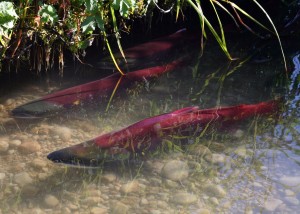19
May
EPA Imposes Pesticide Limits to Protect Salmon in Spite of Industry Refusal to Comply
(Beyond Pesticides, May 19, 2010) EPA has announced plans to place additional limitations on the use of three N-methyl carbamate pesticides — carbaryl, carbofuran and methomyl — to protect endangered and threatened salmon and steelhead in California, Idaho, Oregon and Washington, in compliance with the Endangered Species Act. The decision comes after manufacturers of the chemicals diazinon, malathion and chlorpyrifos refused to adopt the limits voluntarily. 
The new protections are based on recommendations by the National Marine Fisheries Service (NMFS) in their April 2009 Biological Opinion relative to use of the three pesticides to ensure no likely jeopardy to 28 threatened or endangered Pacific salmon and steelhead species. In a May 14, 2010 letter to NMFS, EPA explains how the Agency plans to achieve protection goals through the methods outlined by NMFS in the Biological Opinion or by alternative methods that EPA’s scientific analyses determined will achieve the same purpose. For example, EPA will require pesticide drift buffers adjacent to salmon and steelhead habitat but will impose different width buffers, some wider and others narrower than those recommended by NMFS, depending on factors that affect how far the pesticide might drift from the application site.
In correspondence to the EPA dated May 7, 2010, Dow AgroSciences and Cheminova, manufacturers of the pesticides in question, stated that they were “baffled by the agency’s position,” saying that their products do not threaten endangered species. Citing their “solid scientific evidence”, that they claim is “far more complete than is reflected in the NMFS Biological Opinion,” they are not prepared to make the registration revisions [to their products] described in the EPA’s April 29, 2010 and November 16, 2009 letters.
The changes include the addition of buffer zones; application limitations based on wind speed, soil moisture and weather conditions; and a fish mortality incident reporting requirement. The buffers will apply to surface waters within the geographic range of 22 salmon or steelhead for which NMFS indicated continued use of the pesticides would result in likely jeopardy to the species. The remaining limitations will apply to all surface waters within the geographic range of all 28 salmon and steelhead species in the four states. They will replace interim limitations put in place by the U.S. District Court for the Western District of Washington in 2004.
Previously, NMFS determined that current uses of the pesticides were jeopardizing the existence of west coast salmon and steelhead. EPA, charged with regulating pesticide use, had earlier determined that many salmon runs were not at risk from these pesticides. NMFS’s review found serious flaws with EPA’s analytical methods and conclusions, and determined that EPA underestimated the risk that the pesticides pose to salmon.
In 2002, the Pacific Coast Federation of Fishermen’s Associations, NCAP, and other salmon advocates, with legal representation from Earthjustice, obtained a federal court order declaring that EPA had violated ESA by failing to consult with NMFS on the impacts that certain pesticides have on salmon and steelhead in the Pacific Northwest and California. As a result of that lawsuit, EPA began consultations, but NMFS never issued biological opinions or identified the measures needed to protect salmon and steelhead from the pesticides. In 2007, the salmon advocates filed a second lawsuit and entered into a settlement agreement with NMFS that establishes a schedule for issuing the required biological opinions. Under the terms of settlement, the EPA must implement measures within a year-long timeframe to prevent further exposure of the pesticides to the water that cultivate these species. The measures recommended by NMFS include: a ban on application of the three pesticides in windy conditions and buffer zones near water resources and require that land applications must be at least 50-600 feet from the water resource and aerial spraying requires a 600-1,000 foot buffer zone.
The pesticides that have been reviewed so far are some of the most dangerous chemicals used today. All of them””chlorpyrifos, diazinon, malathion, carbaryl, carbofuran, and methomyl””are neurotoxic and pose serious risks to both humans and wildlife. While many of these pesticides have been phased out for residential use, they continue to expose wildlife and farmworkers through their use in agriculture. Thirty-one more pesticides will undergo review by NMFS over the next three years. The next opinion, reviewing 12 pesticides, is due on June 30, 2010.
Source: EPA Pesticide News Story










